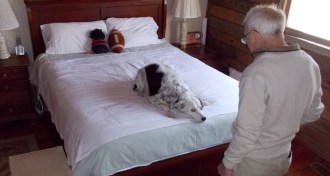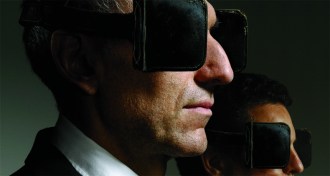Humans
Sign up for our newsletter
We summarize the week's scientific breakthroughs every Thursday.
-
 Health & Medicine
Health & MedicineUnderactive thyroid ups pregnancy risks
Several complications are more common in women with the condition, including gestational diabetes and cesarean births.
By Nathan Seppa -
 Life
LifeResponse to bacterial infection depends on time of day
Mice that got Salmonella in the evening fared better than those given the microbe in the morning.
By Meghan Rosen -
 Life
LifeA molecular window on itch
Researchers discover chemical puppet master behind the need to scratch.
-
 Psychology
PsychologyLess is more for smart perception
Neural efficiency reigns in brains of high-IQ individuals as they view their surroundings, a new study indicates.
By Bruce Bower -
 Psychology
PsychologyDog sniffs out grammar
After years of word training, a canine intuitively figures out how simple sentences work.
By Bruce Bower -
 Humans
HumansTeens take home science gold at Intel ISEF
Self-driving vehicles, battery alternatives and analyses of galaxy clusters claim top prizes at global high school science competition.
By Sid Perkins -
 Humans
HumansHighlights from the Biology of Genomes meeting
Highlights from the genome biology meeting held May 7-11 in Cold Spring Harbor, N.Y., include an enormous tree's enormous genome, genes for strong-swimming sperm, and back-to-Africa migration some 3,000 years ago.
-

-
 Psychology
PsychologyClosed Thinking
Without scientific competition and open debate, much psychology research goes nowhere.
By Bruce Bower -

-
 Life
LifeBody’s clock linked to depression
Gene activity in the brain suggests that circadian rhythms are off-kilter in people with depression.
-
 Humans
HumansEruption early in human prehistory may have been more whimper than bang
If Hollywood’s right, the apocalypse will be brutal. Aliens, nuclear war, zombies, plague, enslavement by supersmart robots — none of them are good endings. Some archaeologists, however, believe an apocalypse has already come and gone. About 75,000 years ago, they say, a monster volcanic eruption nearly wiped out humankind, leaving behind only a few thousand people to […]
By Erin Wayman